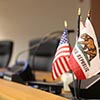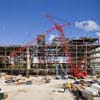Local Governments Maintain Aesthetic Control Over Their Rights Of Way

June 2019
Number 29
A public agency's right to enforce reasonable aesthetic criteria on telecommunications installations is a valid exercise of power. So says the California Supreme Court in its recent ruling inT-Mobile West LLC v. City and County of San Francisco (T-Mobile) (April 4, 2019, S238001) __ Cal. __. In a long-awaited decision by local governments and wireless carriers alike, the court held that local government ordinances requiring aesthetic guidelines for equipment erected by wireless telephone companies were neither preempted by, nor in violation of, state law. Thus, cities and counties need not fear a loss of community quality and aesthetic beauty as a result of unattractive telecommunications installations.
Background
For decades, local governments have battled over the amount of aesthetic control they hold over wireless telecommunications carriers constructing telecommunication facilities located in public rights of way. This struggle by cities and counties to maintain their local character has presented valid concerns regarding the extent of local government regulatory authority. The T-Mobile case settles this squabble by providing local governments with clear authority to establish aesthetic guidelines for wireless carriers locating equipment in public rights of way.
Analysis
In T-Mobile, plaintiffs, national telecommunications carriers including T-Mobile and Crown Castle contended that defendant, the City and County of San Francisco's (City) ordinance which established aesthetic guidelines was preempted by California state law. They asserted that California Public Utilities Code (CPUC) section 7901 preempted the local rule and, even if not preempted, the ordinance violated CPUC section 7901.1 by singling out wireless telecommunications carriers for regulation.
Plaintiffs' preemption argument stemmed from the parties' disagreement over their interpretation of section 7901 which permits wireless carriers to construct and maintain cell towers and wireless facilities along public roads "in such manner and at such points as not toincommode the public use of the road…" Plaintiffs asserted a narrow interpretation of section 7901 stating that the statute granted them the right to construct and erect equipment along public roads, and local governments could not prevent such construction, so long as Plaintiffs did not "obstruct the path of travel." The court disagreed with Plaintiffs, holding that the City's ordinance is not preempted by section 7901, concluding that obstructing the path of travel was just one of multiple ways that public road use could be disturbed or made inconvenient, and that the City retained inherent local police power to regulate the manner and location of telephone line installations of all types. Ruling in favor of the City, the court stated that the statute "leaves room for additional local action" and that there are "significant local interests relating to road use that may vary by jurisdictions."
Plaintiffs additionally asserted that the City's ordinance violated CPUC section 7901.1, which provides that local governments may "exercise reasonable control as to the time, place, and manner" in which roads are "accessed," and that the control must "be applied to all entities in an equivalent manner. Considering the legislative history of section 7901.1, the court held that the statute only applies to temporary access during construction and installation of telephone lines and equipment, and the City's ordinance did not violate the statute because the City did not discriminate amongst entities when regulating temporary access to public rights of way.
Takeaways
The T-Mobile case is a win for cities and counties seeking to maintain their unique character during a time of increased necessity for cell towers and other wireless facilities. The Court here provided clear guidance on local government authority to regulate aesthetics of telecommunication equipment. This may set the stage for future Federal Communications Commission rule-making to attempt to limit this well-deserved affirmation of local control and community quality of life.
If you have any questions about this case or regulation of public rights of way in general, please contact the authors of this Client News Brief or an attorney at one of our eight offices located statewide. You can also subscribe to our podcast, follow us on Facebook, Twitter and LinkedIn or download our mobile app.
Number 29
A public agency's right to enforce reasonable aesthetic criteria on telecommunications installations is a valid exercise of power. So says the California Supreme Court in its recent ruling inT-Mobile West LLC v. City and County of San Francisco (T-Mobile) (April 4, 2019, S238001) __ Cal. __. In a long-awaited decision by local governments and wireless carriers alike, the court held that local government ordinances requiring aesthetic guidelines for equipment erected by wireless telephone companies were neither preempted by, nor in violation of, state law. Thus, cities and counties need not fear a loss of community quality and aesthetic beauty as a result of unattractive telecommunications installations.
Background
For decades, local governments have battled over the amount of aesthetic control they hold over wireless telecommunications carriers constructing telecommunication facilities located in public rights of way. This struggle by cities and counties to maintain their local character has presented valid concerns regarding the extent of local government regulatory authority. The T-Mobile case settles this squabble by providing local governments with clear authority to establish aesthetic guidelines for wireless carriers locating equipment in public rights of way.
Analysis
In T-Mobile, plaintiffs, national telecommunications carriers including T-Mobile and Crown Castle contended that defendant, the City and County of San Francisco's (City) ordinance which established aesthetic guidelines was preempted by California state law. They asserted that California Public Utilities Code (CPUC) section 7901 preempted the local rule and, even if not preempted, the ordinance violated CPUC section 7901.1 by singling out wireless telecommunications carriers for regulation.
Plaintiffs' preemption argument stemmed from the parties' disagreement over their interpretation of section 7901 which permits wireless carriers to construct and maintain cell towers and wireless facilities along public roads "in such manner and at such points as not toincommode the public use of the road…" Plaintiffs asserted a narrow interpretation of section 7901 stating that the statute granted them the right to construct and erect equipment along public roads, and local governments could not prevent such construction, so long as Plaintiffs did not "obstruct the path of travel." The court disagreed with Plaintiffs, holding that the City's ordinance is not preempted by section 7901, concluding that obstructing the path of travel was just one of multiple ways that public road use could be disturbed or made inconvenient, and that the City retained inherent local police power to regulate the manner and location of telephone line installations of all types. Ruling in favor of the City, the court stated that the statute "leaves room for additional local action" and that there are "significant local interests relating to road use that may vary by jurisdictions."
Plaintiffs additionally asserted that the City's ordinance violated CPUC section 7901.1, which provides that local governments may "exercise reasonable control as to the time, place, and manner" in which roads are "accessed," and that the control must "be applied to all entities in an equivalent manner. Considering the legislative history of section 7901.1, the court held that the statute only applies to temporary access during construction and installation of telephone lines and equipment, and the City's ordinance did not violate the statute because the City did not discriminate amongst entities when regulating temporary access to public rights of way.
Takeaways
The T-Mobile case is a win for cities and counties seeking to maintain their unique character during a time of increased necessity for cell towers and other wireless facilities. The Court here provided clear guidance on local government authority to regulate aesthetics of telecommunication equipment. This may set the stage for future Federal Communications Commission rule-making to attempt to limit this well-deserved affirmation of local control and community quality of life.
If you have any questions about this case or regulation of public rights of way in general, please contact the authors of this Client News Brief or an attorney at one of our eight offices located statewide. You can also subscribe to our podcast, follow us on Facebook, Twitter and LinkedIn or download our mobile app.
As the information contained herein is necessarily general, its application to a particular set of facts and circumstances may vary. For this reason, this News Brief does not constitute legal advice. We recommend that you consult with your counsel prior to acting on the information contained herein.





